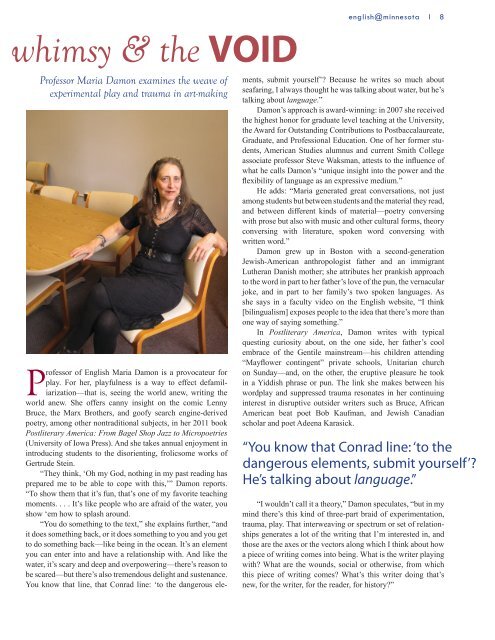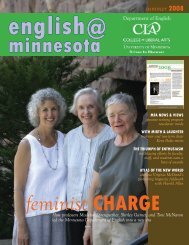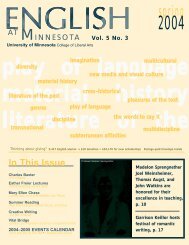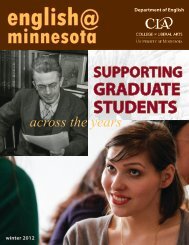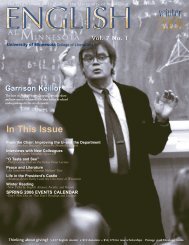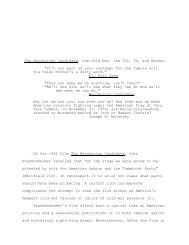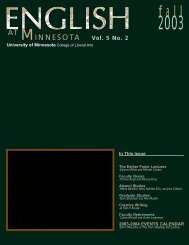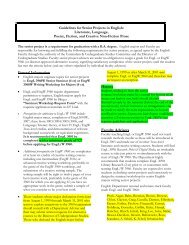Read the 2011 English@Minnesota as a PDF - Department of ...
Read the 2011 English@Minnesota as a PDF - Department of ...
Read the 2011 English@Minnesota as a PDF - Department of ...
Create successful ePaper yourself
Turn your PDF publications into a flip-book with our unique Google optimized e-Paper software.
whimsy & <strong>the</strong> VOID<br />
Pr<strong>of</strong>essor Maria Damon examines <strong>the</strong> weave <strong>of</strong><br />
experimental play and trauma in art-making<br />
Pr<strong>of</strong>essor <strong>of</strong> English Maria Damon is a provocateur for<br />
play. For her, playfulness is a way to effect defamiliarization—that<br />
is, seeing <strong>the</strong> world anew, writing <strong>the</strong><br />
world anew. She <strong>of</strong>fers canny insight on <strong>the</strong> comic Lenny<br />
Bruce, <strong>the</strong> Marx Bro<strong>the</strong>rs, and go<strong>of</strong>y search engine-derived<br />
poetry, among o<strong>the</strong>r nontraditional subjects, in her <strong>2011</strong> book<br />
Postliterary America: From Bagel Shop Jazz to Micropoetries<br />
(University <strong>of</strong> Iowa Press). And she takes annual enjoyment in<br />
introducing students to <strong>the</strong> disorienting, frolicsome works <strong>of</strong><br />
Gertrude Stein.<br />
“They think, ‘Oh my God, nothing in my p<strong>as</strong>t reading h<strong>as</strong><br />
prepared me to be able to cope with this,’” Damon reports.<br />
“To show <strong>the</strong>m that it’s fun, that’s one <strong>of</strong> my favorite teaching<br />
moments. . . . It’s like people who are afraid <strong>of</strong> <strong>the</strong> water, you<br />
show ‘em how to spl<strong>as</strong>h around.<br />
“You do something to <strong>the</strong> text,” she explains fur<strong>the</strong>r, “and<br />
it does something back, or it does something to you and you get<br />
to do something back—like being in <strong>the</strong> ocean. It’s an element<br />
you can enter into and have a relationship with. And like <strong>the</strong><br />
water, it’s scary and deep and overpowering—<strong>the</strong>re’s re<strong>as</strong>on to<br />
be scared—but <strong>the</strong>re’s also tremendous delight and sustenance.<br />
You know that line, that Conrad line: ‘to <strong>the</strong> dangerous ele-<br />
english@minnesota l<br />
ments, submit yourself’? Because he writes so much about<br />
seafaring, I always thought he w<strong>as</strong> talking about water, but he’s<br />
talking about language.”<br />
Damon’s approach is award-winning: in 2007 she received<br />
<strong>the</strong> highest honor for graduate level teaching at <strong>the</strong> University,<br />
<strong>the</strong> Award for Outstanding Contributions to Postbaccalaureate,<br />
Graduate, and Pr<strong>of</strong>essional Education. One <strong>of</strong> her former students,<br />
American Studies alumnus and current Smith College<br />
<strong>as</strong>sociate pr<strong>of</strong>essor Steve Waksman, attests to <strong>the</strong> influence <strong>of</strong><br />
what he calls Damon’s “unique insight into <strong>the</strong> power and <strong>the</strong><br />
flexibility <strong>of</strong> language <strong>as</strong> an expressive medium.”<br />
He adds: “Maria generated great conversations, not just<br />
among students but between students and <strong>the</strong> material <strong>the</strong>y read,<br />
and between different kinds <strong>of</strong> material—poetry conversing<br />
with prose but also with music and o<strong>the</strong>r cultural forms, <strong>the</strong>ory<br />
conversing with literature, spoken word conversing with<br />
written word.”<br />
Damon grew up in Boston with a second-generation<br />
Jewish-American anthropologist fa<strong>the</strong>r and an immigrant<br />
Lu<strong>the</strong>ran Danish mo<strong>the</strong>r; she attributes her prankish approach<br />
to <strong>the</strong> word in part to her fa<strong>the</strong>r’s love <strong>of</strong> <strong>the</strong> pun, <strong>the</strong> vernacular<br />
joke, and in part to her family’s two spoken languages. As<br />
she says in a faculty video on <strong>the</strong> English website, “I think<br />
[bilingualism] exposes people to <strong>the</strong> idea that <strong>the</strong>re’s more than<br />
one way <strong>of</strong> saying something.”<br />
In Postliterary America, Damon writes with typical<br />
questing curiosity about, on <strong>the</strong> one side, her fa<strong>the</strong>r’s cool<br />
embrace <strong>of</strong> <strong>the</strong> Gentile mainstream—his children attending<br />
“Mayflower contingent” private schools, Unitarian church<br />
on Sunday—and, on <strong>the</strong> o<strong>the</strong>r, <strong>the</strong> eruptive ple<strong>as</strong>ure he took<br />
in a Yiddish phr<strong>as</strong>e or pun. The link she makes between his<br />
wordplay and suppressed trauma resonates in her continuing<br />
interest in disruptive outsider writers such <strong>as</strong> Bruce, African<br />
American beat poet Bob Kaufman, and Jewish Canadian<br />
scholar and poet Adeena Kar<strong>as</strong>ick.<br />
“You know that Conrad line: ‘to <strong>the</strong><br />
dangerous elements, submit yourself’?<br />
He’s talking about language.”<br />
“I wouldn’t call it a <strong>the</strong>ory,” Damon speculates, “but in my<br />
mind <strong>the</strong>re’s this kind <strong>of</strong> three-part braid <strong>of</strong> experimentation,<br />
trauma, play. That interweaving or spectrum or set <strong>of</strong> relationships<br />
generates a lot <strong>of</strong> <strong>the</strong> writing that I’m interested in, and<br />
those are <strong>the</strong> axes or <strong>the</strong> vectors along which I think about how<br />
a piece <strong>of</strong> writing comes into being. What is <strong>the</strong> writer playing<br />
with? What are <strong>the</strong> wounds, social or o<strong>the</strong>rwise, from which<br />
this piece <strong>of</strong> writing comes? What’s this writer doing that’s<br />
new, for <strong>the</strong> writer, for <strong>the</strong> reader, for history?”


